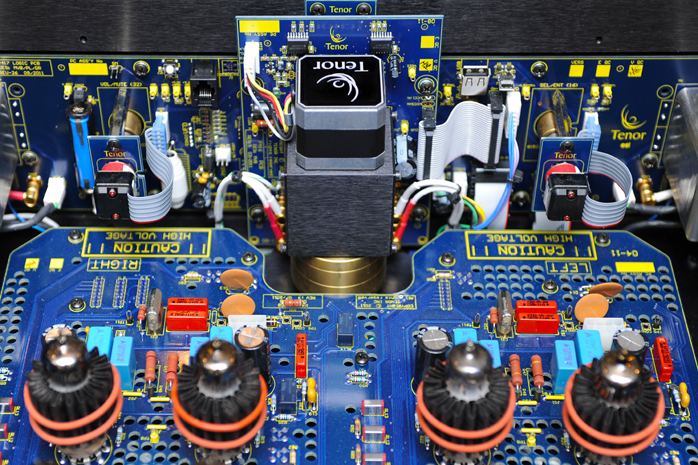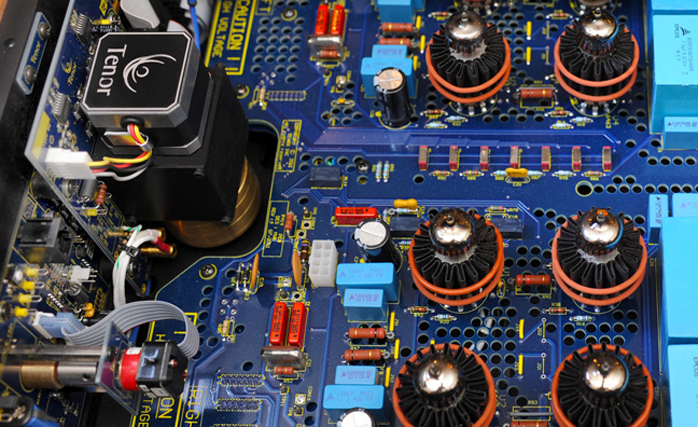This review page is supported in part by the sponsors whose ad banners are displayed below |
 |
 |
"When you use a potentiometer, the advantage is to always present the same load to the preceding amplification stage. Let's say the potentiometer is 20kΩ. The amplification stage will always see a 20kΩ load. This is very important. Distortion characteristics of gain circuits vary as a function of load, hence it is critical that the load be stable. You cannot easily do that with other solutions except for L-pad and T-pad systems which do offer constant impedance but are less ideal due to size, switching and multiple contacts. That said, all potentiometers are definitely not created equal. Our search ended with Alps in Japan. Our unit is fully machined from brass with multiple internal shields for noise rejection. The resistive track is mirror-finished and very shiny so that when the wiper circulates across it, it makes no noise and is totally silent. That’s because they use hundreds of very fine gold-plated brushes. This is the single most expensive volume control in the world and the single most expensive part in the preamp. But we really had no other choice. The entire signal goes through the volume control so it must be perfect."
|
 |
For remote control, a motor must couple to the pot but its massive size and weight coupled with the harmful effects of the motor’s physical vibrations prompted Michel to separate the volume control on an isolated board away from the main circuit. This allowed critical dampening of the volume control and the luxury of mounting the entire assembly on isolated vibration absorbers so as to not transmit noise to the audio board. Even the internal coupling between motor and volume control is dampened, allowing deformation without vibration transmission.
For the required motorization Tenor developed an elegant solution using a microprocessor-controlled stepper motor with 200 individual stops per revolution feeding an optical encoder. That recognizes a position, sends that data to the logic board which directs the signal to the motor drive which moves the pot. Although optical encoders are expensive, when you physically rotate them there is no resistance to feel like nothing. On the other hand turning this Alps exudes elegance because the Tenor team developed brass bushings, stainless steel shafts and a special lubricating grease to ensure that the optical encoder would exhibit the same tactile feel as the direct Alps action. The result is an elegant silky-smooth mechanical control and another small example of Tenor’s obsessive attention to detail.
|
|
|
The final step in our little tech detour is the output stage. For a preamp you want low output impedance to properly drive long cables. Whenever you locate a volume control past the gain stages, you will never have consistent low output impedance due to the latter’s dependence on the potentiometer’s wiper position. That achieves the lowest impedance at maximum volume which in actual use will never be the case. The more you attenuate the higher the output impedance gets. That’s no good.
To correct this problem, Tenor uses an output current buffer, "a discrete solid-state symmetrical circuit working in pure class A at 120 mA which is quite high current. We want absolutely no sonic contribution from this buffer so we had to develop a circuit that generates zero distortion using a very specific topology with no feedback. With an output impedance of 4 ohms we can drive a signal through 300m (1,000 feet) of cable with no change in the distortion characteristics. There's enough power from the preamp to actually drive a small speaker although not loudly."
|
 |
Since the distortion generated by the tubes is tailored to be neutral, the buffer was designed to not to alter the sound from the tube voltage gain stage. The buffer thus only has one purpose – to convert voltage to current without adding distortion. It’s a tall order but critical so Michel designed a buffer circuit that inherently cancels its own distortion without feedback. He calls it a "transfer function correction which is differential in nature." Each transistor is selected to generate distortion that is the exact reciprocal value of the other transistor for total cancellation. "In the buffer stage we measured harmonic distortion in parts per million which is essentially nothing and almost down to the noise floor of the Audio Precision measuring instrument. The purpose was to get a straight-line transfer function."
|
 |
Residual noise is proportional to the position of the volume control. Listening at '5' which is barely audible, noise will be -125dB as a function of the immeasurable residual buffer noise. "This is part of a larger process to eliminate noise in a very natural way, including finding the inverse distortion curves for devices in a way that is not detrimental to the signal. In fact it's quite complementary. Since the noise is so low, dynamic range is exceptionally high." The result is that the Line1/Power1 can be loaded at 100Ω, 600Ω, 1kΩ or 10kΩ with no difference in distortion or noise. You could connect fifty Tenor amplifiers to the output without affecting distortion levels.
|
|
|
An interesting side effect of the output buffer is that it minimizes cable effects. A cable driven with a low-current high-impedance preamp exhibits a certain amount of high frequency roll-off and distortion. Conversely Tenor’s high-current low-impedance output can charge and discharge a very large capacitance which renders electrical characteristics between cables far smaller. Michel claims that with the Line1/Power1 a cable’s physical characteristics such as the metals and insulators matter more than its electrical characteristics to make for greater uniformity within systems. Another advantage of Tenor’s low output impedance is noise. The amplifier ‘sees’ close to a short circuit. Think of it as putting a shorting plug in an amplifier to reduce noise. It’s the same effect. Still interested in a few more technical details? Here are a few more culled from Michel’s comments.
- Tenor obsessively controls vibrations including multiple stages of decoupling via wood and rubber in the feet, internal board mountings, suspensions and dampening material on the interior surfaces.
- The audio board suspension was calculated for a resonant frequency of 20Hz because microphony effects appear between 100Hz and a few thousand hertz. The suspension was designed for a much lower frequency to ensure that everything would be captured and damped and nothing transmitted to the audio circuits.
- The input board is shielded against airborne RF.
- The majority of internal wires are silver-plated copper with Teflon insulation for stability and superior insulating properties with a low dielectric constant. Special oil is used during the extruding process and the combination guarantees that this wire will not oxidize even after 20 years. Similar wire is used in critical aircraft circuits. With Michel’s background in military aviation, one see hints of this in the wires, shielding and bundling.
- Electrolytic capacitors are spec’d to 105°C (221°F) for long-term reliability.
- Film capacitors are selected and tested for distortion.
- Resistors are selected for a variety of parameters including temperature stability, voltage coefficient and the abilities to sustain transients without creating distortion or failure.
- The PC boards are 1/10th of an inch thick with 3 ounces of copper per square foot which is very thick. This allows narrower trace widths to reduce capacitance effects.
- The cables are measured and selected to eliminate parasitic voltages from signal transmission or vibrations.
- The fuse contains a ceramic tube silver wire surrounded by sand to prevent the wire from dissipating heat. Therefore the fuse blows very quickly in reaction to an overload and is carefully placed in the circuit to eliminate distortion caused by the fuse itself.
- Cardas connectors are used throughout.
- Internally the unbalanced connections use a special cable and connector from the microwave industry made from copper and silver, with Teflon insulation and ultra-stable SMB connectors for reliability.
This is a small sampling. There are additional technology facts likely of interest to some readers. But since this is a review not propaganda piece, I've included additional comments from Michel and Jim in a separate interview.
|
 |
  |
 |
|